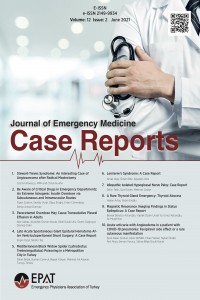Öz
Abstract
Introduction: The hypoglossal nerve (xii. Nerve) in the central bulbus contains only motor fibers. After leaving the brain stem, the fibers coming out of it pass through the canalis hypoglossis in the occipital bone and move to the parafarengeal cavity and then to the level of the occipital artery, reaching the suprahioid region. It passes behind the milohyoid and hyoglossus muscles and reaches the intrinsic muscles of the tongue. In addition, stylolossus innervates the hyoglossus and genioglossus muscles.
Case Report: A 16-year-old female patient addmited to our emergency room with the complaint of her tongue turning left (not rotating) in her mouth for 3 days, no head injury. Brain examinations and tests were normal. She got better with antipsychotic, dopaminergic, anticholinergic treatment.
Conclusion: We are in this article; We tried to investigate rare idiopathic hypoglossal nerve palsy causes with the literature.
Anahtar Kelimeler
HYPOGLOSSAL NERVE PALSY TONGUE DISEASES NEUROLOGICAL DISEASES
Kaynakça
- Referans1. Odar V. Ankara. Anatomi: Hacettepe Taş Kitapçılık (1986); 437-8.
- Referans2. Janfaza P, Nadol JB, Jr. Scalp, Cranium & Brain Surgical Anatomy of the Head and Neck, eds Janfaza P, Nadol JB, Galla RJ, Richard RL, Montgomery WW. Lippincott Williams & Wilkins (2001)
- Referans3. Peköz, Taylan; Filiz, K. O. Ç.; BOZDEMIR, Hacer. Orofaringeal Manuplasyona Bağlı Unilateral Hipoglossal Sinir Paralizisi. Cukurova Medical Journal (2012), 37.2: 107-111.
- Referans4. Combarros, O., A. Alvarez De Arcaya, and J. Berciano. "Isolated unilateral hypoglossal nerve palsy: nine cases." Journal of neurology 245.2 (1998): 98-100.
- Referans5. Keane, James R. "Twelfth-nerve palsy: analysis of 100 cases." Archives of Neurology 53.6 (1996): 561-566.
- Referans6. Hoehn, Margaret M., et al. Parkinsonism: onset, progression, and mortality. Neurology (1998), 50.2: 318-318.
- Referans7. Lagalla G. Influence of early high-dose steroid treatment on Bell's palsy evolution. Neurol Sc (2002); 23. 107-12.
Öz
Kaynakça
- Referans1. Odar V. Ankara. Anatomi: Hacettepe Taş Kitapçılık (1986); 437-8.
- Referans2. Janfaza P, Nadol JB, Jr. Scalp, Cranium & Brain Surgical Anatomy of the Head and Neck, eds Janfaza P, Nadol JB, Galla RJ, Richard RL, Montgomery WW. Lippincott Williams & Wilkins (2001)
- Referans3. Peköz, Taylan; Filiz, K. O. Ç.; BOZDEMIR, Hacer. Orofaringeal Manuplasyona Bağlı Unilateral Hipoglossal Sinir Paralizisi. Cukurova Medical Journal (2012), 37.2: 107-111.
- Referans4. Combarros, O., A. Alvarez De Arcaya, and J. Berciano. "Isolated unilateral hypoglossal nerve palsy: nine cases." Journal of neurology 245.2 (1998): 98-100.
- Referans5. Keane, James R. "Twelfth-nerve palsy: analysis of 100 cases." Archives of Neurology 53.6 (1996): 561-566.
- Referans6. Hoehn, Margaret M., et al. Parkinsonism: onset, progression, and mortality. Neurology (1998), 50.2: 318-318.
- Referans7. Lagalla G. Influence of early high-dose steroid treatment on Bell's palsy evolution. Neurol Sc (2002); 23. 107-12.
Ayrıntılar
| Birincil Dil | İngilizce |
|---|---|
| Konular | Klinik Tıp Bilimleri |
| Bölüm | Case Report |
| Yazarlar | |
| Yayımlanma Tarihi | 11 Haziran 2021 |
| Gönderilme Tarihi | 23 Aralık 2020 |
| Yayımlandığı Sayı | Yıl 2021 Cilt: 12 Sayı: 2 |


